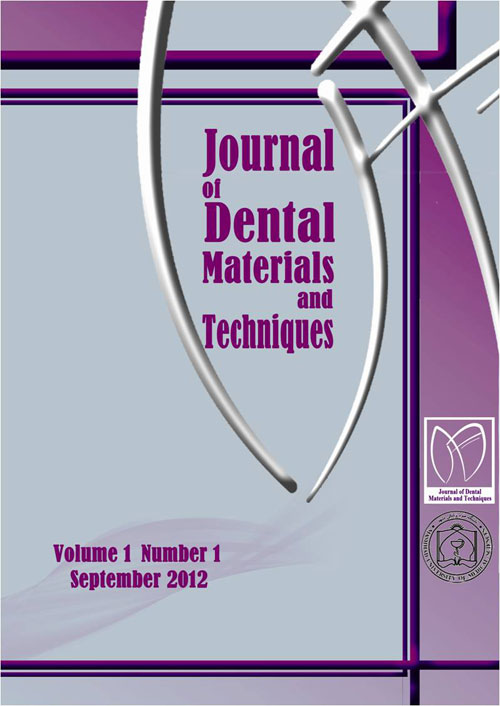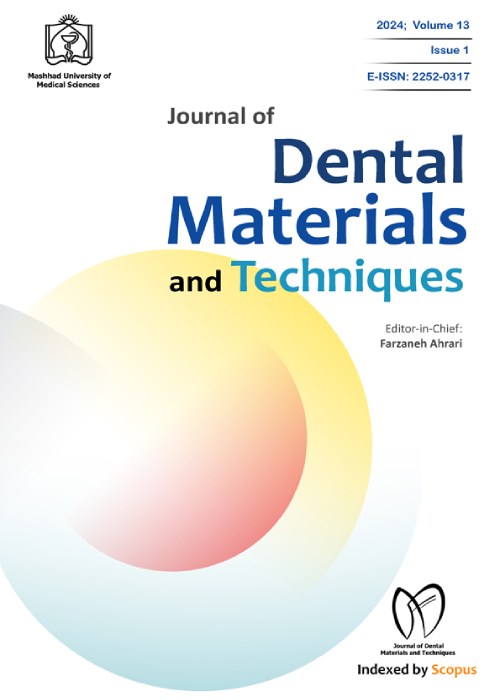فهرست مطالب

Journal of Dental Materials and Techniques
Volume:8 Issue: 4, Autumn 2019
- تاریخ انتشار: 1398/08/25
- تعداد عناوین: 8
-
-
Pages 159-168Introduction
The aim of this study was to perform a systematic review and meta-analysis to compare the effect of bone-borne expansion (BBE) and tooth-borne expansion (TBE) in patients with maxillary constriction.
MethodsElectronic databases, including MEDLINE, EMBASE, and Cochrane Central Register of Controlled Trials, were searched up to February 2019. Eligible clinical trials and cohort studies that studied the effects of bone-borne and tooth-borne expansion appliances on patients with constricted maxilla were selected. The study selection, data extraction, and risk of bias assessment were independently performed by two authors. Then, the random-effects meta-analysis and post-hoc heterogeneity tests were performed.
ResultsIn the end, four studies were included in the present meta-analysis (i.e., a randomized clinical trial, two prospective controlled clinical trials, and a cohort study) that collected data from 117 patients. The mean differences between TBE and BBE were 0.38 mm and -0.28 mm for premolar and molar apices, 0.67 mm and 1.18 mm for premolar and molar crowns, 0.19 mm and 0.17 mm for alveolar bone in premolar and molar areas, and -0.61 mm and 0.02 mm for nasal and maxillary bones, respectively. Moreover, the differences between TBE and BBE for dental angulation were 3.84◦ and 1.52◦ for left and right molars, as well as 4.85◦ and 3.46◦ for left and right premolars, respectively.
ConclusionThe BBE appliances do not have any advantages over tooth-borne devices with regard to the amount of skeletal or dental expansion; however, it seems to produce less tipping in posterior teeth.
Keywords: Palatal Expansion Technique, Orthodontic Appliances, Fixed, Orthodontic Anchorage Procedures -
Pages 169-173
The amounts of apical enlargement have been a controversial issue for a long time. The enlargement of the apical part of the canal may severely impact the endodontic prognosis. Enlargement of the apical portion to a larger size may negatively affect the ability to control the filling material during root canal obturation. In addition, an open-apex increases the risk for overfilling which has been shown to be related with decreased success rate. The retreatment of a tooth with apically enlarged canal may be even impossible. Further preparation of an apically enlarged canal may increase the risk of iatrogenic errors and also excessive apical root weakness. The present article aimed to address in vitro and clinical studies on apical enlargement, effect of coronal pre-flaring on the size of the master apical file, and clinical applications of apical enlargement.
Keywords: Apical enlargement, coronal enlargement, penetration of bacteria -
Pages 174-181Introduction
Using irrigation solutions in pulpectomy procedures for children is the best technique to dissolve and remove the soft necrotic materials during instrumentation. Normal saline solution (NSS) has no antibacterial activity and only results in root canal cleaning during irrigation. The 2% chlorhexidine gluconate (CHX) solution significantly decreases bacterial colonies, compared to NSS. The present study was performed to evaluate the success of irrigation by NSS and CHX combined solution, in comparison to NSS.
Materials and MethodsThe current study was conducted on 60 children aged 6‒9 years allocated to the two groups of test and control. All the participants had one primary molar tooth with signs and symptoms of irreversible pulpitis. During pulpectomy of the 30 teeth, the standard technique, consisting of irrigation with 0.9% NSS was used for the control group. The 30 teeth of the remaining subjects in the case group were irrigated with an equal volume of 0.2% CHX and NSS combination. Clinical radiographic follow-ups were scheduled at 6 and 12 month post-operation intervals.
ResultsThe success rates at 12 month follow-up from clinical and radiographic viewpoints in the control group were 83% and 73%, respectively. For the case group, success rates of 97% and 90% were reported clinically and radiographically, respectively. There were no significant diffferences between the case and control groups at 6- (P= 0.492) and 12- (P= 0.195) month clinical follow-ups. On the other hand, the two groups were siginificantly different regarding the 6-month radiographic follow-up (P=0.038); however, such difference was not significant at the 12-month follow-up (P=0.095).
ConclusionTheone-year follow-up showed that there is no diffference between CHX and NSS as irrigation solutions for cleaning the root canals of primary teeth with irreversible pulpitis.
Keywords: Chlorhexidine gluconate, Normal saline solution, Primary molar, Pulpectomy -
Pages 182-189Introduction
the Restoration of endodontically treated teeth is critical, and the Awareness of stresses developed by oblique and vertical forces in restorative methods take a great role in treatment plans. Due to the anatomical shape and inherent form of the stress distribution premolars, could be lost by fractures. Some fractures such as vertical fracture which is probable in endodontically treated teeth, makes the teeth a candidate for extraction and other surgical procedures. According to this fact that the dental restorations should be conservative, the aim of this study was to determine stress distribution using four composite restorative methods.
MethodsEndodontically treated maxillary second premolars were restored with composite resin using four methods. For restoration, the models representing standard Mesio-occlusal-distal (MOD) restoration, cusps capping with thickness of 1 and 2mm, and the use of woven fiber in occlusal part, were prepared. The effects of the different restorative approaches on stress distribution were analyzed using three-dimensional finite element stress analysis.
Resultsthe highest stress rate was observed in MOD tooth restoration and the amount of stress in natural parts of the tooth in woven fiber was found the lowest.
ConclusionThe simulation results show that in all models, oblique forces caused more stress than vertical forces. Moreover, there was a slight difference between different types of restorations regarding the magnitude of stress; however, the results obtained from this study showed that woven fiber could partly reduce stresses.
Keywords: Endodontically Treated Finite Element Analysis Restorative Dentistry Resin Composites Woven Fibers -
Pages 190-196Introduction
Anxiety is an emotional state that helps healthy people defend themselves against threats. Dental anxiety is referred to a patient's specific response to stressful dental practices. The prevalence of dental anxiety is estimated to be between 3-43%. The relation between dental caries and dental anxiety is well understood, which happen as the result of patient’s avoidance of dental visits. We aimed to measure dental fear in patients and evaluate its relationship with general anxiety.
MethodsThis cross-sectional study was performed on 90 patients referred to Oral medicine Department of Rasht Dental School in winter 2016. The severity of dental fear was measured by DFS Questionnaire and the level of general anxiety was measured by Cattell’s anxiety scale. Pearson’s correlation coefficient, t-test, and ANOVA were used for data analysis.
ResultsTotal anxiety in 81 (90%) of the subjects was higher than the average. The mean total score of anxiety was 5.74 (SD=1.82). Sixty one (67.8%) of the patients had significantly higher anxiety than average and anxiety level in 70 (77.8%) of them was more than moderate. Pearson’s correlation coefficient showed that there was a positive and significant relationship between general anxiety and dental anxiety (P<0.01, R=0.262). Independent t-test showed that the mean score of dental anxiety in males (M=33.82, SD=14.96) was significantly less than females (F=40.09) (P=0.048).
ConclusionAccording to the results of this research, there is a significant correlation between dental anxiety and general anxiety and also between dental anxiety and gender.
Keywords: dental fear, dental anxiety, general anxiety, Trait anxiety, state anxiety -
Pages 197-204
Many patients use household cleaners to clean denture which can cause discoloration and damage soft liners. The purpose of this study was to evaluate the effect of household cleansers on the color change of two types of permanent soft liners.
MethodsIn this interventional study, 80 permanent silicone soft liners, including 40 heat-cured liners (Molloplast-B, Detax Gmbh & Co. KG, Ettlingen, Germany) and 40 self-cure liners (Mucopren soft, Kettenbach GmbH & Co. KG, Eschenburg, Germany) were made in brass molds with dimensions of 15×2 mm in accordance with the manufacturer's instructions. The samples were immersed in distilled water for 24h and the initial color was determined using a colorimeter. Then, each group (n=10) was immersed for 8h daily in 2.5% vinegar, 2.5% hypochlorite, 2.5% hand washing liquid, and distilled water (control). Color measurements were performed after 7 and 30 days of immersion in solutions and data were analyzed using ANOVA, independent t-test, and Tukey's post hoc tests.
ResultsIn distilled water, hypochlorite, and vinegar, the mean color change after one month was significantly lower in Molloplast-B than Mucopren (P=0.042, P<0.001, P=0.002); however, in Hand washing, the difference was not significant (P=0.780).
ConclusionThe mean color change in Mucopren in all cleansers was higher than Molloplast-B, and the highest change in color was observed in both liners in hypochlorite.
Keywords: Soft liner material Color change Household cleansers -
Pages 205-214Introduction
The present study aimed to evaluate an experimental herbal mouthwash, as compared to sodium fluoride mouthwash on the frictional resistance and surface roughness between brackets and two rectangular archwire types.
MethodsA total of 60 premolar׳s brackets engaged with 0.019×0.025 archwires made of stainless steel and nickel-titanium alloys were used in this study. The samples were assigned into three groups, each group contained ten stainless steel archwires-brackets and ten nickel titanium archwires-brackets combination. Thereafter, these samples were immersed in herbal mouthwash, sodium fluoride mouthwash (study groups) and artificial saliva (control group) for 90 minutes. Universal testing machine was used to test the friction resistance in the three groups. Atomic force and scanning electron microscopes were used to evaluate the surface roughness of wires and bracket surface topography, respectively.
ResultsThe samples immersed in sodium fluoride mouthwash illustrated the highest mean friction resistance and mean surface roughness, followed by herbal mouthwash and the least was for artificial saliva.
ConclusionThe 90-minute immersion in herbal mouthwash did not exert any significant effect on frictional resistance or surface roughness among orthodontic brackets and archwires made of stainless steel and nickel titanium. Based on the results, herbal mouthwash may be prescribed as a non-destructive prophylactic agent on materials evaluated in the present study for the orthodontic patient.
Keywords: Mouthwashes, Friction, Surface roughness, Stainless steel, Nickel titanium -
Pages 215-220
The nickel-titanium (Ni-Ti) alloys used in endodontics contain 56% Ni and 44% Ti. The 2 unique features related to clinical dentistry (i.e., shape memory effect and superelasticity) are due to the transition from austenite to martensite in Ni-Ti alloy. When a superelastic Ni-Ti alloy undergoes a low tensile loading, normal elastic behavior occurs. In fact, at higher tensile loads, the elastic stress may reach a level at which there is extended horizontal region of elastic strain. The shape-memory property of Ni-Ti is derived from an atomic arrangement different from that of alloys like stainless steel. The purpose of this paper was to review the unique features of this alloy and mechanism of corrosion.
Keywords: Corrosion, Endodontics, Ni-Ti, Root Canal, Preparation, Rotary Instrument


